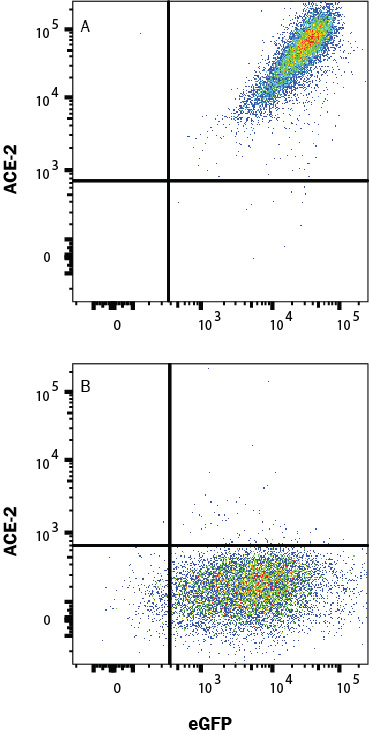Human/Rat/Hamster ACE-2 Antibody Summary
Gln18-Ser740
Accession # Q9BYF1
Applications
Please Note: Optimal dilutions should be determined by each laboratory for each application. General Protocols are available in the Technical Information section on our website.
Scientific Data
 View Larger
View Larger
Detection of Human ACE‑2 by Western Blot. Western blot shows lysates of human kidney and human testis. PVDF membrane was probed with 2 µg/mL of Mouse Anti-Human/Rat/Hamster ACE‑2 Monoclonal Antibody (Catalog # MAB9332) followed by HRP-conjugated Anti-Mouse IgG Secondary Antibody (HAF018). A specific band was detected for ACE‑2 at approximately 120 kDa (as indicated). This experiment was conducted under reducing conditions and using Western Blot Buffer Group 1.
 View Larger
View Larger
Detection of ACE-2 in HEK293 Human Cell Line Transfected with Human ACE-2 and eGFP by Flow Cytometry. HEK293 human embryonic kidney cell line transfected with (A) human ACE-2 or (B) irrelevant protein, and eGFP was stained with Mouse Anti-Human ACE-2 Monoclonal Antibody (Catalog # MAB9332) followed by Allophycocyanin-conjugated Anti-Mouse IgG Secondary Antibody (F0101B). Quadrant markers were set based on Mouse IgG2A Isotype Control (MAB003). Staining was performed using our Staining Membrane-associated Proteins protocol.
 View Larger
View Larger
ACE‑2 in Rat Kidney. ACE‑2 was detected in immersion fixed frozen sections of rat kidney using Mouse Anti-Human ACE‑2 Monoclonal Antibody (Catalog # MAB9332) at 1 µg/mL overnight at 4 °C. Before incubation with the primary antibody, tissue was subjected to heat-induced epitope retrieval using Antigen Retrieval Reagent-Basic (CTS013). Tissue was stained using the NorthernLights™ 557-conjugated Anti-Mouse IgG Secondary Antibody (red; NL007). Specific staining was localized to convoluted tubules. Staining was performed using our protocol for Fluorescent IHC Staining of Frozen Tissue Sections.
 View Larger
View Larger
ACE‑2 in Hamster Lung. ACE‑2 was detected in immersion fixed paraffin-embedded sections of hamster lung using Mouse Anti-Human ACE‑2 Monoclonal Antibody (Catalog # MAB9332) at 10 µg/mL for 1 hour at room temperature followed by incubation with the Anti-Mouse IgG VisUCyte™ HRP Polymer Antibody (VC001). Before incubation with the primary antibody, tissue was subjected to heat-induced epitope retrieval using Antigen Retrieval Reagent-Basic (CTS013). Tissue was stained using DAB (brown) and counterstained with hematoxylin (blue). Specific staining was localized to respiratory bronchioles. Staining was performed using our protocol for IHC Staining with VisUCyte HRP Polymer Detection Reagents.
Reconstitution Calculator
Preparation and Storage
- 12 months from date of receipt, -20 to -70 °C as supplied.
- 1 month, 2 to 8 °C under sterile conditions after reconstitution.
- 6 months, -20 to -70 °C under sterile conditions after reconstitution.
Background: ACE-2
Angiogensin I Converting Enzyme-2 (ACE-2), also called ACEH (ACE homolog), is a type I transmembrane zinc protease that cleaves angiotensins I and II to produce vasodilatory and anti-proliferative peptides. The balance between ACE-1 and ACE-2 activity is critical for maintaining cardiovascular, renal, and pulmonary function (1). ACE-2 also functions as the cellular uptake receptor for the SARS coronoavirus. Within the extracellular domain, human ACE-2 shares 83% aa sequence identity with mouse and rat ACE-2. Human ACE-2 has about 40% amino acid identity to the N- and C-terminal domains of human somatic ACE. The predicted human ACE-2 protein sequence consists of 805 amino acids, including a N-terminal signal peptide, a single catalytic domain, a C-terminal membrane anchor, and a short cytoplasmic tail. ACE-2 mRNA is found at high levels in testis, kidney and heart and at moderate levels in colon, small intestine and ovary. Classical ACE inhibitors such as captopril and lisinopril do not inhibit ACE-2 activity. Novel peptide inhibitors of ACE-2 do not inhibit ACE activity (2). Genetic data from Drosophila, mice and rats show that ACE-2 is an essential regulator of heart function in vivo (3). ACE-2 isoforms of 75 kDa and 120 kDa are differentially expressed between lung and kidney, respectively, and a shed soluble form is generated by TACE/ADAM17 mediated cleavage.
- Tipnis, S.R. et al. (2000) J. Biol. Chem. 275:33238.
- Crackower, M.A. et al. (2002) Nature 417:822.
- Huang, L. et al. (2003) J. Biol. Chem. 278:15532.
Product Datasheets
Citations for Human/Rat/Hamster ACE-2 Antibody
R&D Systems personnel manually curate a database that contains references using R&D Systems products. The data collected includes not only links to publications in PubMed, but also provides information about sample types, species, and experimental conditions.
4
Citations: Showing 1 - 4
Filter your results:
Filter by:
-
Superimmunity by pan-sarbecovirus nanobodies
Authors: Y Xiang, W Huang, H Liu, Z Sang, S Nambulli, J Tubiana, KL Williams, WP Duprex, D Schneidman, IA Wilson, DJ Taylor, Y Shi
Cell Reports, 2022-06-08;39(13):111004.
Species: Human
Sample Types: Whole Cells
Applications: Flow Cytometry -
Characterization and functional interrogation of the SARS-CoV-2 RNA interactome
Authors: A Labeau, L Fery-Simon, A Lefevre-Ut, M Pourcelot, L Bonnet-Mad, V Soumelis, V Lotteau, PO Vidalain, A Amara, L Meertens
Cell Reports, 2022-04-26;39(4):110744.
Species: Human
Sample Types: Whole Cells
Applications: Flow Cytometry -
Identification of cell type specific ACE2 modifiers by CRISPR screening
Authors: EJ Sherman, C Mirabelli, VT Tang, TG Khan, K Leix, AA Kennedy, SE Graham, CJ Willer, AW Tai, JZ Sexton, CE Wobus, BT Emmer
PloS Pathogens, 2022-03-01;18(3):e1010377.
Species: Human
Sample Types: Whole Cells
Applications: Flow Cytometry -
ACE2 protein expression within isogenic cell lines is heterogeneous and associated with distinct transcriptomes
Authors: EJ Sherman, BT Emmer
Scientific Reports, 2021-08-05;11(1):15900.
Species: Human
Sample Types: Cell Lysates, Whole Cells
Applications: Flow Cytometry, IHC, Western Blot
FAQs
No product specific FAQs exist for this product, however you may
View all Antibody FAQsReviews for Human/Rat/Hamster ACE-2 Antibody
Average Rating: 5 (Based on 1 Review)
Have you used Human/Rat/Hamster ACE-2 Antibody?
Submit a review and receive an Amazon gift card.
$25/€18/£15/$25CAN/¥75 Yuan/¥2500 Yen for a review with an image
$10/€7/£6/$10 CAD/¥70 Yuan/¥1110 Yen for a review without an image
Filter by:




